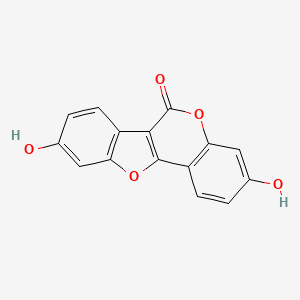COUMESTROL
COUMESTROL is a lipid of Polyketides (PK) class. Coumestrol is associated with abnormalities such as Infertility, Renal tubular disorder, Osteoporosis, Postmenopausal, Nodule and Central precocious puberty. The involved functions are known as Process, antagonists, Accident due to exposure to weather conditions, physiological aspects and Cell Proliferation. Coumestrol often locates in Blood, Body tissue, Reproductive system, Membrane and Myometrial. The associated genes with COUMESTROL are GAPDH gene, PPID gene, pyridinoline, NODAL gene and Nitrogen fixation gene. The related lipids are enterodiol. The related experimental models are Mouse Model.
References related to functions published in Others
| PMID | Journal | Published Date | Author | Title |
|---|---|---|---|---|
| 15579483 | Carcinogenesis | 2005 | Javid SH et al. | Modulation of tumor formation and intestinal cell migration by estrogens in the Apc(Min/+) mouse model of colorectal cancer. |
| 22307307 | Appl. Environ. Microbiol. | 2012 | Lee HI et al. | Effect of soybean coumestrol on Bradyrhizobium japonicum nodulation ability, biofilm formation, and transcriptional profile. |
| 28396216 | Toxicol. Appl. Pharmacol. | 2017 | Lecomte S et al. | Assessment of the potential activity of major dietary compounds as selective estrogen receptor modulators in two distinct cell models for proliferation and differentiation. |
| 17644650 | Mol. Pharmacol. | 2007 | Enokizono J et al. | Effect of breast cancer resistance protein (Bcrp/Abcg2) on the disposition of phytoestrogens. |
| 21098648 | Cancer Epidemiol. Biomarkers Prev. | 2011 | Hedelin M et al. | Dietary phytoestrogens and the risk of ovarian cancer in the women's lifestyle and health cohort study. |
| 18579710 | Mol. Pharmacol. | 2008 | Ekins S et al. | Computational discovery of novel low micromolar human pregnane X receptor antagonists. |
| 26921498 | Biochim. Biophys. Acta | 2016 | Chai SC et al. | Small-molecule modulators of PXR and CAR. |
| 26698565 | J. Endocrinol. | 2016 | Lim W et al. | Coumestrol suppresses proliferation of ES2 human epithelial ovarian cancer cells. |
